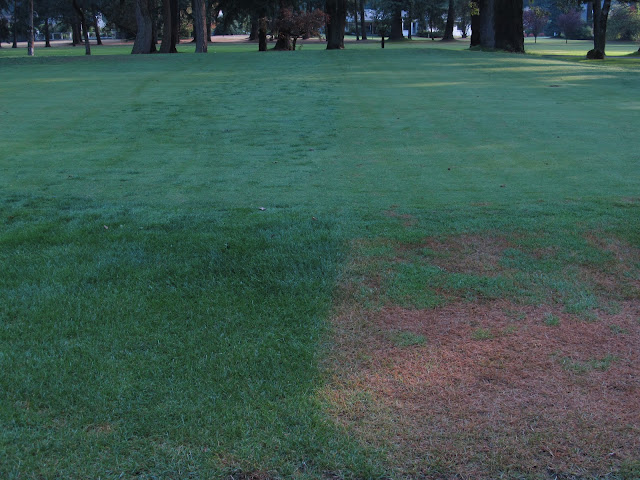Tomorrow it will be 13 days since greens aeration and so they should be pretty good since they have been healing well with unseasonably warm temperatures. There are a few greens however that will show the scars of aeration a week or two longer. Those are greens #1, #4, #9, and #13. The reason for this extra recovery time is we used the deep tine aerator on them and that was quite disruptive.
Here is a picture of the deep tine machine on #9. Click on the video below to see it in action. This is a 1/2" tine penetrating 10 inches deep.
Why did we deep tine some greens and not all of them? Well, serious problems require serious solutions. The greens we deep tined don't drain well and start to get soft during the winter. I'm very hopefull that the deep tine alleviates the poor drainage on these greens. Over the next month we will deep tine all the greens but not this aggressively and therefore we will not have a serious problem getting them smooth again. Here's a picture of us getting serious with the rolling as we rented a steam roller for smoothing out the greens we deep tined this past week. Our regular rollers should have no problem smoothing out the other greens once we deep tine them.
This past week we punched most of the fairways and teeways. Unfortuantely, we have had such dry conditions that the regular hollow tine operation was causing too much damage. Specifically, the dry soil conditions allowed the surface to be loosened too much by the aerator. When this happens, the core harvesting machine has a tendency to grab turf and cause lots of tearing. To avoid having many, many areas to repair, we opted to just solid tine the fairways and teeways. Even this process heaved up turf quite a bit but since we didn't need to use the harvesting machine, nothing has gotten torn up too bad. It is really nice to see the sand going down on the teeways. This is the best thing for getting them smooth and consistent with the fairway turf. Speaking of teeways, here's a video of us mowing the 13th.
Before we had teeways, this tee complex looked like this. This picture was taken right after we restored this areas following the installation of the sewer line back in 2010. Back then I was still mowing stripes on the fairways..................................Wow, we sure have gotten smarter in the last couple years.
Lastly, remember this picture of my experiment with a new herbicide.
Here we are spraying the new herbicide called Segment. The objective is to kill the ryegrass that is growing amongst our pure poa stands. So here is how the trial turned out. These pictures were taken 2 weeks after we applied the product to our nursery green.
Turf on the left of this photo was untreated and the turf on the right side of the photo was obviously treated since a lot of it doesn't look too hot. Actually the green is just fine as only the ryegrass died. The poa never even discolored. In the foreground of the picture, you can see that almost all the turf is dead on the treated side. This is because this areas was recently cut out and reestablished with ryegrass since that is what we always use for our roughs when starting from seed or sod. The picture below is a close up of the short mowed area. You can clearly see how well the dark ryegrass clumps are no longer present in the treated turf on the right.
Needless to say I am very amazed how well this product selectively kills ryegrass. Now I have hope that our teeways will look like our very mature poa fairways in only a few seasons. We will soon be experimenting with this product on the golf course with the hopes to use a lot of it next spring to speed the transition of mixed turf stands to pure poa stands. Very exciting stuff!
Turf on the left of this photo was untreated and the turf on the right side of the photo was obviously treated since a lot of it doesn't look too hot. Actually the green is just fine as only the ryegrass died. The poa never even discolored. In the foreground of the picture, you can see that almost all the turf is dead on the treated side. This is because this areas was recently cut out and reestablished with ryegrass since that is what we always use for our roughs when starting from seed or sod. The picture below is a close up of the short mowed area. You can clearly see how well the dark ryegrass clumps are no longer present in the treated turf on the right.
Needless to say I am very amazed how well this product selectively kills ryegrass. Now I have hope that our teeways will look like our very mature poa fairways in only a few seasons. We will soon be experimenting with this product on the golf course with the hopes to use a lot of it next spring to speed the transition of mixed turf stands to pure poa stands. Very exciting stuff!








No comments:
Post a Comment